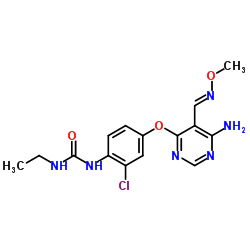951151-97-6
| Name | Urea, N-[4-[[6-amino-5-[(methoxyimino)methyl]-4-pyrimidinyl]oxy]-2-chlorophenyl]-N'-ethyl |
|---|---|
| Synonyms |
1-[4-({6-Amino-5-[(E)-(methoxyimino)methyl]-4-pyrimidinyl}oxy)-2-chlorophenyl]-3-ethylurea
Urea, N-[4-[[6-amino-5-[(E)-(methoxyimino)methyl]-4-pyrimidinyl]oxy]-2-chlorophenyl]-N'-ethyl- JNJ-38158471 JNJ 38158471 (E)-1-(4-(6-amino-5-((methoxyimino)methyl)pyrimidin-4-yloxy)-2-chlorophenyl)-3-ethylurea |
| Description | JNJ-38158471 is a well tolerated, orally available, highly selective VEGFR-2 inhibitor, with an IC50 of 40 nM. JNJ-38158471 also inhibits Ret and Kit with the IC50s of 180 and 500 nM, respectively[1]. |
|---|---|
| Related Catalog | |
| Target |
VEGFR-2:40 nM (IC50) RET:180 nM (IC50) c-Kit:500 nM (IC50) |
| In Vitro | JNJ-38158471 (1-500 nM; 1 hour) inhibits VEGF-stimulated VEGFR-2 autophosphorylation in HUVECs[1]. JNJ-38158471 (50-1000 nM; 12-16 hours) significantly inhibits VEGF-dependent HUVEC migration. Cellular toxicity is not observed following JNJ-38158471 treatment of HUVECs[1]. Western Blot Analysis[1] Cell Line: Human umbilical vein endothelial cells (HUVECs) Concentration: 1, 10, 100, 500 nM Incubation Time: 1 hour Result: Reduced phospoho-VEGFR2 levels at 95, 88, 77 and 73% with the concentration of 500, 100, 10 and 1 nM, respectively. |
| In Vivo | JNJ-38158471 (10 or 100 mg/kg; p.o.; once-daily) inhibits VEGF-induced corneal neovascularization[1]. JNJ-38158471 (10-200 mg/kg; p.o.) inhibits the growth of human tumor xenografts in a dose-dependent manner in both A431 and HCT116 models. JNJ-38158471 treatment is well tolerated, following continuous administration for 24 days, body weights were comparable with control animals[1]. JNJ-38158471 (100 mg/kg; p.o.; once-daily) treatment shows statistically significant activity compare with vehicle treat animals. The body weights of both JNJ-38158471-treated and vehicle-treated groups were comparable at study end[1]. Animal Model: Female C57BL/6J mice are implanted with rhVEGF165[1] Dosage: 10 or 100 mg/kg Administration: Daily oral administration for 6 days Result: Caused a marked and apparently dose-dependent inhibition of VEGF-dependent blood vessel formation (100 mg/kg, resulted in 83% inhibition; 10 mg/kg, resulted in 15% inhibition). Animal Model: Female athymic nude mice; 5-6 weeks; implanted subcutaneously human colorectal carcinoma cells (HCT116) or human epidermoid carcinoma cells (A431)[1] Dosage: 10, 50, 100, 200 mg/kg Administration: Oral administration for 35 days Result: Achieved optimum efficacy with the dose from 100 to 200 mg/kg daily. Animal Model: Female athymic nude mice; 5-6 weeks; implanted subcutaneously human skin melanoma cells (A375)[1] Dosage: 100 mg/kg Administration: Once-daily oral administration for 28 days Result: Inhibited 90% growth of tumor with daily doses of 100 mg/kg. Animal Model: Female C57BL/6J-Apc Min mice; 5 weeks of age[1] Dosage: 100 mg/kg Administration: Once-daily oral administration for two weeks Result: Inhibited polyp formation in the transgenic APC min-mouse model. |
| References |
| Density | 1.4±0.1 g/cm3 |
|---|---|
| Molecular Formula | C15H17ClN6O3 |
| Molecular Weight | 364.787 |
| Exact Mass | 364.105072 |
| PSA | 123.75000 |
| LogP | 4.05 |
| Index of Refraction | 1.637 |
| Hazard Codes | Xi |
|---|
